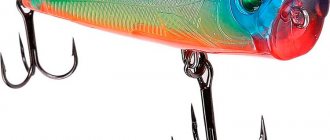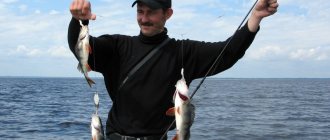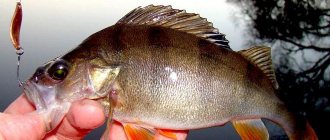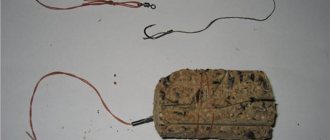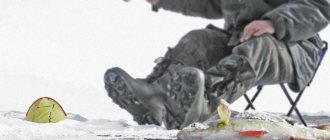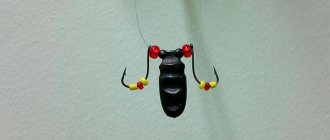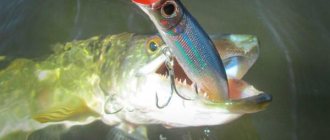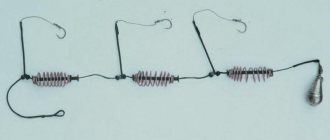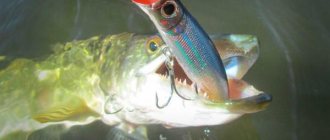What is a popper
Popper is a bladeless surface wobbler with an elongated or slightly rounded body. Its distinctive feature is a funnel-shaped depression in the head part (“spitter”), making it look like a small fish with a wide open mouth. When retrieving, this depression creates characteristic gurgling sounds - as if a fry on the surface is grabbing insects (mosquitoes, midges) that have fallen into the water or are flying low above it.
The length of this bait ranges from 3-4 to 12-15 cm, weight - from 2-3 to 18-20 grams.
The wobbler is equipped with two triple or double hooks with a soft edge. The hooks are located on wire loops-suspensions on the abdomen, in the tail part. The color of the wobbler can be either natural, like a fry of perch, rudd or roach, or bright unnatural colors (acid green, yellow). The wobbler is attached to the fishing line or the latch of the metal leash using a loop with a ring located inside its nose recess.
These fish are made from durable plastic, balsa. Most models have a sound chamber inside the body with small balls, which, when the wobbler plays, create sounds that attract predators.
On a note
When looking for the best popper, most anglers prefer hard plastic models. This material, unlike balsa wood, is stronger, more durable, and less scratched when grabbed by a predator.
Popper classification
A variety of such surface baits is classified depending on the location of the load - the shift of the center of gravity to the tail, head part of the wobbler, or its uniform distribution throughout the body of the bait.
Based on this feature, these wobblers are divided into:
- Front-loaded - most of the weight in such baits is concentrated in the head part.
- Rear-loaded - the main part of the weight is shifted to the tail of the popper.
- Lures with weights distributed evenly throughout the body.
Check the distribution of the load by lowering a popper attached to a fishing line into an aquarium or container with clear water. Based on which part of the wobbler is the most recessed, it is determined which of the types described above it belongs to.
On a note
The division of these plastic fish into floating or sinking poppers is incorrect, since these bladeless wobblers do not dive deeper than 10-15 cm.
Review of Skitter Pop Rapala 7cm, 7 grams.
This popper is already more than 12 years old, I bought it in 1998, the wobbler is really Finnish, the VMC tees, despite the rust, still remain sharp, as if I just took it out of the package yesterday. The paint and varnish coating is at a high level, as is the balsa material from which this wobbler is made - despite the number of pikes and perches that were caught on it, the popper is still like new! Skitter, perhaps, remains one of my favorite lures of this type to this day. Any more or less savvy fisherman who knows how to hold a spinning rod in his hands and use a reel can effectively control this wobbler. I already wrote above about the neighbor’s boy, my wife, in general, also quite quickly mastered the wiring technique and also caught this bait more than once. Thanks to the very wide “mouth” of this wobbler, it creates a huge amount of splashes and a very peculiar loud “Shock” sound when retrieving.
Read Trout Spawning
When retrieving, the wobbler moves slightly deviating from the given trajectory of movement, either to the left or to the right, the buoyancy of this popper is high, so it practically does not go under water, and accordingly its operation is very stable even with a small wave and even more so in complete calm. Nevertheless, casting a wobbler of this particular size and weight leaves much to be desired, in my opinion, due to improper balancing - when casting, the Skitter flies chaotically tumbling like a cutlet. Nevertheless, throwing it at 35-40 meters will not be difficult even with the short spinning rod that I had during the test. Personal rating: 5 points.
Choosing fishing gear
Rod and reel
For fishing with such a wobbler, use a rod with the following characteristics:
- Length - 2.1−2.4 meters.
- The build is super fast.
- Test - 10−30 grams.
- The blank material is graphite.
Jig blanks with a thin, sensitive tip are not suitable for fishing with poppers. The spinning rod for this bait is chosen from twitching models, with a hard, durable whip, a comfortable spaced handle made of EVA, and a reliable reel seat.
An inertia-free reel installed on a spinning rod must have the following characteristics:
- Forest capacity (size) - 2500−3000.
- Gear ratio - 5.0−5.2:1.
- The number of bearings is at least 4-5 installed in the transmission mechanism, line roller, knob.
- Body material: aluminum alloy, carbon fiber.
- Weight - no more than 300 grams.
fishing line
Fishing tackle for popper fishing is equipped with a bright-colored braided cord with a cross-section of 0.08−0.12 mm. Monofilament fishing line with a thickness of 0.18−0.22 mm is used when fishing for perch in small ponds with a maximum casting distance of no more than 15 meters.
On a note
The bright color of the cord is necessary in order to see in low light conditions where the bait is located, to which place it goes at the end of the line.
Detailed description of the bait
To put it simply, a popla popper is a small float with the properties of a popper.
. It has, as a rule, a teardrop shape, in its frontal part there is a familiar notch to create slurping sounds and splashes, but at the back, in the place where the classic popper has a tee, there is a regular loop for securing the leash.
They do not have a blade for deepening or a propeller. The leash is usually taken no longer than 12 - 15 cm
, it is equipped with a single hook, preferably with a long shank. Some artificial bait imitating a worm, larva, etc. is attached to the hook. In some cases, to activate the bite, a live worm or maggot is attached. Fishing for it is done using a light spinning rod.
Today there are two types of this interesting industrially produced bait on the market:
- MPP.
They have a head size of 23 mm. - BPP.
They have a slightly larger head - 30 mm.
The standard sizes of a pop-popper are very small; their length may vary, but, as a rule, it does not exceed 30 - 35 mm
, and the weight is in the range of
2 – 4 g
. In this regard, it is not without reason that it is believed that the popla popper is intended for, or at least for light tackle.
They are available in three colors
: white, yellow and the so-called “red fly agaric”, dark red, and BPP type baits come only in yellow and red. For greater visibility when fishing at long distances, some samples are marked with small black spots.
Read Stands for feeders and how to make them yourself
Fishing technique and tactics
Popper fishing techniques and tactics include the correct choice of place and time of fishing, retrieving, hooking, and retrieving.
Choosing a place and time of fishing
The most successful fishing is with bladeless surface wobblers in the summer, from June to the end of August. In autumn, as it gets colder and aquatic vegetation dies off, their catchability decreases significantly, giving way to heavy sinking wobblers, oscillating spoons, twisters and vibrotails.
Such plastic fish are used in reservoirs where other baits will often cling. Such places include:
- Shallow river oxbows and bays overgrown with grass.
- Snagged ponds, lakes.
- “Zhabovniki” are shallow lakes heavily overgrown with grass, bets.
- River sections with weak currents and a large amount of aquatic vegetation on the surface.
Popper fishing is inconvenient and ineffective in clear sections of rivers with medium or fast currents. In such conditions, the wobbler will be strongly carried away by the flow of water and will not animate well.
Wiring Features
When fishing with a popper, use a classic twitching (jerk) retrieve, performed as follows:
- After casting, unwind the slack line and wait for a while until the fish stops creating ripples around itself.
- In order to easily control the wobbler, the tip of the blank is lowered as close to the water as possible.
- After the wobbler has become motionless, they begin to wind the cord with a reel, while making short and sharp jerks with the tip of the rod. Evidence of good wiring is a characteristic gurgling sound and a trail of bubbles left behind the fish.
On a note
The jerk force should be such that the bait does not jump out of the water, but only creates a splash and the necessary sound. Wiring consisting of jerks and pauses lasting 2-3 seconds is also possible. The wiring of the popper depends on the activity of the fish: for a sluggish and inactive predator, wiring with jerks and long pauses is used. When catching active fish, they use a retrieve in which each jerk alternates with a short pause or without it at all.
Hooking and landing
A bite on such a surface wobbler is felt not only “in the hand”, but is also visible visually by the splash next to the wobbler. In this case, they hook with a sharp and short jerk. They land the fish carefully, not giving it the opportunity to drag the wobbler into the bushes, grass, or snags.
Features of using bait
Of course, fishing with a popper is very exciting and is an active type of fishing. You can catch both ordinary, peaceful fish and predators.
In order for fishing to be effective, you need to select the appropriate equipment for it. The popla popper rig has its own characteristics:
- A light class rod
should not be longer than 2.4 meters, even if casting will be done from the shore. With such a fishing rod it is easier to make long and accurate casts of light bait. - It is better to take a light reel
(1000 - 1500), of the inertia-free type. The sensitivity of the gear largely depends on the quality of its work. - As the main fishing line, small diameter braided line
. It is able to withstand the resistance of a large rudd or other fish, even if it goes into the reeds after hooking. A fishing line with a breaking load of up to 5.5 kg is sufficient. - The hooks must be of high quality
, designed so that grass carp may be caught and can unbend them during an active fight.
As a rule, fishing for poplar popper takes place in overgrown areas of the reservoir.
, where they try to throw it into a clean window in the middle of vegetation or on the border between the grass and a clean area of the reservoir. An important element in attracting the attention of fish when fishing with this bait is the technique of its placement:
- if the fish is active, then the classic method of poppers
, fast jerks with small pauses of 2 - 3 seconds; - if the fish is inactive, then the pauses need to be increased
, giving the fish a better look at the bait on the hook.
Read What gear and rigs to use for asp fishing
In addition, it has been noticed that at different times baits of different colors are more catchy:
- in early spring or late autumn, as well as on a sunny summer day, red and yellow poplar poppers work best;
- The white color attracts fish when fishing in the shade of trees or under bridges.
Another interesting feature of this equipment is that when retrieving a popper, the popper attracts fish with its sounds and splashes, and during pauses it becomes a regular float - a classic bite alarm.
Knipovich Nikolai Mikhailovich
Zoologist, hydrobiologist. Graduated from Leningrad State University named after Zhdanov, Faculty of Biology and Soil Sciences. I am interested in fishing at a professional level.
I made the “Perch-Lite” popper specifically for fishing with my ultralight spinning rod for catching perch on the surface of the water. My spinning rod is from 0 to 5 grams, and these are the criteria I adhered to (size, weight, volatility, stability in the game and starting the game with half a turn, low cost, reliability and ease of manufacture).
To be honest, the popper has shown itself to be excellent in catching perch and pike from the surface of reservoirs, and what is especially important is that it can be placed in hard-to-reach places and carried through a place overgrown with grass and algae, where, as you know, toothy predators and striped robbers like to live
How to make a popper yourself
You can make a popper with your own hands from such simple materials as a wine cork or wood.
From the traffic jam
A homemade popper is made from a wine cork using the following technology:
- At the ends of the cork, lines are drawn through the center with a marker.
- A frame consisting of three hanging loops - front, back and abdominal - is bent from steel wire.
- The loops are fixed with a winding of thin copper wire.
- The cork is sawed lengthwise to the middle.
- A wire frame is placed in the cut.
- In the cut, 3-4 notches are also made for loading.
- Lead pellets weighing 0.7-1.0 grams are inserted into the recesses.
- Fine shavings are poured into the cut and thoroughly impregnated with waterproof transparent glue.
- After the glue has dried, the body of the popper is treated with a transparent waterproof varnish.
- A hole is made in the beer cork of such a diameter that the front loop of the wire frame passes through it.
- The end of the bait and the reverse (flat) side of the beer cap are coated with durable epoxy waterproof glue.
- Glue the beer cap to the body of the bait.
- Two artificial eyes are glued to the sides of the bait.
You can see the bait making process more clearly in the video below:
Made of wood
The process of making a popper from wood is as follows:
- A birch block 5-7 cm long and 1.5-2 cm in diameter is ground to a cone.
- The wide (head) part is cut at an angle of about 300.
- A recess is made at the end of the wide part - a “spitter”. To do this, first scrape out a small hole with a knife, widen it with a drill and sand it with coarse-grained sandpaper.
- A cut is made on the belly of the bait.
- A wire frame and loading pellets are inserted into the cut.
- Wood shavings mixed with waterproof glue are poured into the cut.
- After the glue hardens, the abdomen is treated with sandpaper.
The entire manufacturing process is clearly shown in more detail in the following video:
On a note
More accurate dimensions and drawings for fishing and making such bait can be found on fishing forums.
Hooks
A homemade popper is equipped with strong and large triple, less often double hooks No. 3−2.
Lure coloring
The color does not affect the catchability of the bait in any way - the predator sees it from below and does not react even to the most realistic colors. The color of the wobbler is more important for the angler himself, who needs to see the bait from a long distance in twilight, ripples or waves. Therefore, the best popper should be painted in colors that are visible on the water - green, white, red, etc.
How to choose a popper
Catchable poppers are selected according to length, type of load, based on such criteria as the object being fished and casting distance.
To size
- With a bait size of 5-6 cm, the angler can count on catching large perch, small pike, and asp.
- For medium and large pike and asp, the most suitable baits are those with a length of more than 7 cm.
By casting distance
- If it is necessary to cast over long distances, rear-loaded baits are used.
- The best popper for short-range fishing should have a weight located at the front or evenly distributed throughout the body.
On a note
The shape of the popper affects its casting distance. Lures with an elongated body can be cast further than those with a more rounded body.
